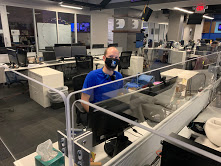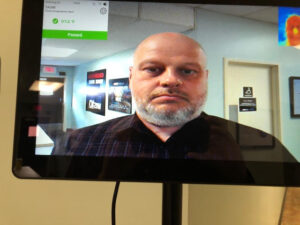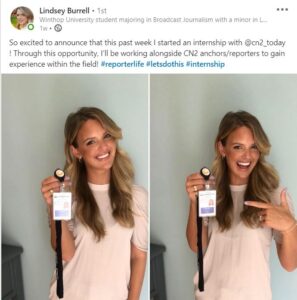COVID-19 and the Newsroom of 2020
By Dennis Milligan
It’s rare that the story you’re covering as a journalist directly impacts you, your family and your newsroom. However, that’s the reality of 2020, as news organizations balance priorities, keeping the public informed and journalists safe in the face of the coronavirus.
In the Carolinas, the newsroom landscape is remarkably quiet, by most accounts. On-site staffing is kept to a minimum. Mask wearing is mandatory in many locations. Barriers have been installed between work stations. Thermometers and hand sanitizer stations have become as common as cameras and notepads as the tools of the trade. Temperature screenings take place before entering stations. Many stations offer regular, free coronavirus testing to employees. The rare positive cases are contact traced and potentially exposed people are notified and offered testing. “With 25 years in news, I have seen stomach bugs and the flu take down a newsroom. I’m thankful we have been so cautious and so quick to get everyone out of the office and working from home. It has absolutely minimized spread, protected our people and our product,” says Cathy Hobbs, News Director of WCIV in Charleston, SC.
“We have drastically reduced the number of people who work in the building,” reports Kim Saxon, News Director of CBS affiliate, WBTV in Charlotte, NC. “MMJs and photographers have take-home vehicles and most don’t come into the newsroom at all. Shifts have been adjusted to minimize overlap and we have changed seating in the newsroom to spread people out during each shift.” Many newscast producers can build their shows from home, and in automated control rooms, show directors can even punch a show from home. At WBTV, news management rotates in-station duties on a weekly basis. “One team is in the newsroom, the other works from home for a week, then they switch.”

Stations have deployed a variety of technology so that people can work and broadcast from home. Meetings are held by conference call, Microsoft Teams or Zoom. Brad Hyatt is the News Director for WIS, the NBC affiliate in Columbia, SC. He notes that technology, while critical to COVID-19 era news operations, is not a total solution. “The lack of face-to-face time with staff and the inability to really brainstorm as a group takes away from the dynamic.” And Hyatt notes the distance between talent hurts the on-air product. “One anchor on set and another in their extra room at home just doesn’t have the same feel. We can get close, but it lacks the same connectivity, energy, and chemistry you get when a team is really cranking on all cylinders on set.”

In terms of coverage, the pandemic is forcing newsrooms to make decisions that focus on safety. In the case of WBTV in Charlotte, it drastically reduced the number of people on site at the Republican National Convention and did not send teams to the coast when Hurricane Isaias threatened. “We weren’t going to put a crew on the beach, just to get whipped around by the wind, ” says Saxon.
The coronavirus has changed the hiring process for many stations. It’s gone virtual. “We have hired about a half-dozen people who didn’t set foot in the building until two weeks after they started working for us.” according to Saxon. “Those who started with us early in the pandemic and have never been in the same room with 75-80% of their coworkers.” With teleconferencing, Saxon notes, “I have employees who have never seen the lower half of my body. It’s a whole new world!”
Another pandemic casualty is the student internship. Since outsiders are generally not allowed inside of TV stations right now, college seniors are hard pressed to get that hands-on experience which often opens the door to a first job. Colleges and stations are trying to find ways to bridge the gap. One way is by news professionals offering critiques of student work via email. There are some exceptions. CN2 News in Rock Hill, SC recently brought on Winthrop Student Lindsey Burrell who says, “It was extremely difficult to find an internship due to COVID-19. I sent my resume to six different news stations, most of which told me that due to the virus, they couldn’t even consider taking interns until spring of 2021. Some stated that they were unsure if they would even be able to have interns in the spring. As a senior graduating next May, I was afraid that I wouldn’t gain the necessary experience in a news station that I needed when applying for my first job post-grad. I’m extremely thankful for Comporium and CN2 for this hands-on opportunity!”

It has been said that adversity reveals the strength of organizations. This is true of Carolina newsrooms and COVID-19. Hobbs is proud of her team and the job they have done under difficult circumstances. “Yes, balls have been dropped. That happens even without COVID. I will be grateful when everyone is back in the newsroom.”
Looking ahead to the future, it must be asked if working remotely, social distancing and other COVID-19 procedures are the new normal. “I hope not,” says Hobbs. “We need communication and collaboration for the editorial process. I miss my team!”